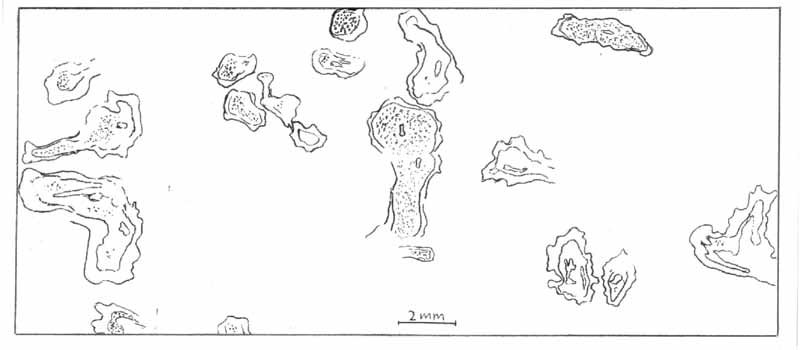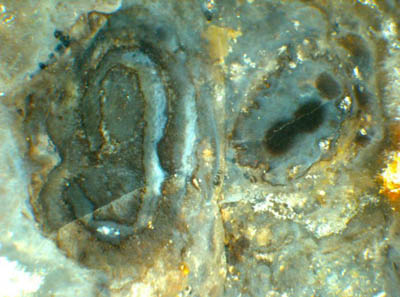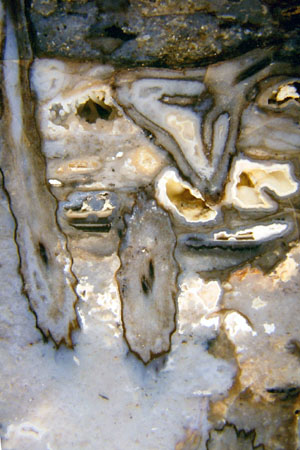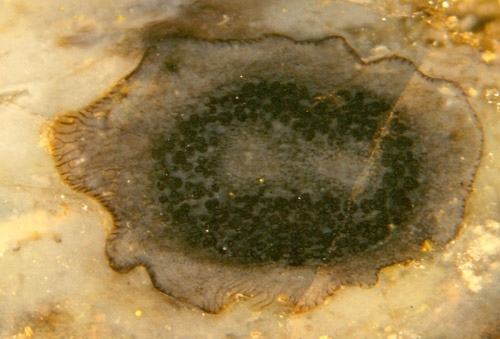Horneophyton
sporangia as odd-shaped bags
Horneophyton
had been one of the four land plants discovered early in
the Rhynie chert [1]. Nevertheless it has defied any attempt to group
it with other fossil or extant plants, mainly because of its branched
sporangia which are unique among all spore-bearing plants. Not only
their shape is peculiar but also their interior: There is a central
“tree” inside whose branches extend into the lobes of the sporangium.
(A
central column, called columella, is known from the sporangia of the
hornworts. Hence, Horneophyton
and the hornworts have something in common but the similarity of the
names is incidental.) The
peculiar build of the Horneophyton
sporangium had been pictured in
[2] as an obviously simplified schematic drawing (Fig.1).

Fig.1: Horneophyton
sporangium as usually pictured, from [2].
Fig.2 (right): Cut face of Rhynie chert with numerous
sections of Horneophyton
sporangia, with or without spores. (Sections
of other parts have been omitted.) Note the pipe-like lobe (far left),
the big bag with two small columella cross- sections (centre), and the
thick base of the branching columella (far right). Two columella
cross-sections seen in a two-lobed se ction
(far left) indicate that the
sporangium had four lobes at least.
ction
(far left) indicate that the
sporangium had four lobes at least.
Disregarding evidence for more irregular shapes [2,3], the drawing in
Fig.1 was
redrawn many times, with slight variations for copyright reasons,
apparently by
people who never saw a Horneophyton
sporangium in reality, and has been
repeatedly published in palaeobotany textbooks and on websites as if it
were the real thing.
Although it is difficult to reconstruct a typical shape from the
sections seen on cut chert faces in random orientation as in Fig.2, it
became obvious soon that shape and size of the sporangia were
distinctly variable and different from Fig.1. They can be rather
simple with only one (?) or two lobes but never as regular as in Fig.
1, and possibly as odd-shaped as pictured in Fig. 3. With the
combination of bulky bag and narrow pipe some specimens may
even resemble a bagpipe. 
Fig.3: Tentative reconstruction of a
variety of the rather variable Horneophyton
sporangium, with the
original principle of dichotomous branching modified by asymmetry,
after own observations.
Fig.4 (right): Cross-sections of Horneophyton
parts. Right: shoot with
shrivelled surface and forking central strand with two equal prongs not
yet se parated, (fungus clot
above). Left: Cross-section of a sporangium
near its base where the broad columella is still connected to the wall
on one side, and separate prongs are just being formed.
parated, (fungus clot
above). Left: Cross-section of a sporangium
near its base where the broad columella is still connected to the wall
on one side, and separate prongs are just being formed.
The principle of dichotomy or forking as it is
known from the shoots
(Fig.4) is still there with the sporangia, as seen in sections near
the base (Figs.4,5,6). However, a tendency towards asymmetry takes over
soon. By the way, the transition from dichotomous to asymmetrical
branching is an ancient phenomenon in several clades of the plant
system.
 Fig.5
(left): Sections of Horneophyton
parts: apparently simple-shaped
variety of the
sporangium with forking columella, shoot with forking xylem strand
(below).
Fig.5
(left): Sections of Horneophyton
parts: apparently simple-shaped
variety of the
sporangium with forking columella, shoot with forking xylem strand
(below).
Fig.6 (below):
Cross-section of a sporangium near its base where the prongs of the
columella are not yet separated; spores in clusters of four called
tetrads. Note the epidermis cells on
the left seen from inside.
Width of
the section 2.8mm.

A
conclusion may be drawn from the pictures: While Fig.1 suggests a
similarity to the sporangia of the hornworts (and probably had been
influenced by knowledge of the latter), the real shapes hardly do.
Whether the odd-shaped sporangia evolved by the fusion of simpler ones
or else by an increasing complexity of shape is still an unsolved
problem.
H.-J. Weiss
2006
[1] R.
Kidston, W.H. Lang : On Old Red Sandstone plants
showing structure, Part II.
Trans. Roy Soc. Edinburgh
52(1920),
603-627.
[2] D.A.
Eggert : The sporangium of Horneophyton lignieri.
Amer. J. Bot. 61(1974), 405-413.
[3] W.El-S.
El-Saadawy, W.S. Lacey : The sporangia of
Horneophyton lignieri.
Rev. Palaeobot. Palyn. 28(1979),
137-144.
 |
 |
15 |



 ction
(far left) indicate that the
sporangium had four lobes at least.
ction
(far left) indicate that the
sporangium had four lobes at least.
 parated, (fungus clot
above). Left: Cross-section of a sporangium
near its base where the broad columella is still connected to the wall
on one side, and separate prongs are just being formed.
parated, (fungus clot
above). Left: Cross-section of a sporangium
near its base where the broad columella is still connected to the wall
on one side, and separate prongs are just being formed. Fig.5
(left): Sections of Horneophyton
parts: apparently simple-shaped
variety of the
sporangium with forking columella, shoot with forking xylem strand
(below).
Fig.5
(left): Sections of Horneophyton
parts: apparently simple-shaped
variety of the
sporangium with forking columella, shoot with forking xylem strand
(below).

